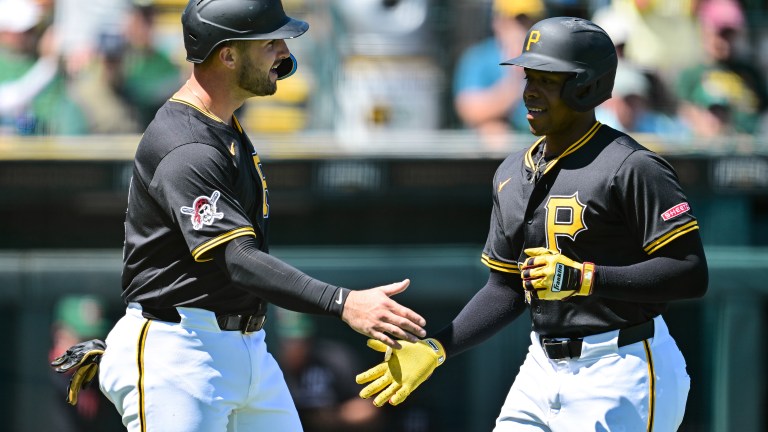Ke’Bryan Hayes Comes With Complicated Trade Value
While he's been the best defensive third baseman in baseball, Ke'Bryan Hayes will be a tricky piece for the Pirates to try to trade at the deadline.

This year’s trade deadline is set to be one of the heaviest seller’s markets in years, and the Pittsburgh Pirates are set to be at the forefront of this market.
With the team currently at just 38-56 and possessing a lot of movable contracts, they’re potentially in for a wild deadline day.
If they do decide to sell, the Pirates will have more pitching options available than anything else. However, they’ve made it clear that they’re looking to free up some money from the books, following a trend that has been seen nearly every year in the Bob Nutting era.
One way to do this may be by trading third baseman Ke’Bryan Hayes. While Hayes has had moments where he’s looked very good, he’s certainly been a mixed bag for the team at best. He’s in a complicated situation, as he’s struggled at the dish, struggled to stay on the field, and overall hasn’t lived up to his expectations.
Hayes also comes with an eight-year, $70 million extension, adding to the challenges teams would have to work around when trading for him.
However, in this complicated trade situation, there is a chance for a lot of upside. Let’s dive a little deeper into Hayes’ trade value and complications that come with moving him.
Lack of Offensive Production
When Hayes first arrived on the big league scene in 2020, the future seemed bright for him offensively. Although it was just 24 games, Hayes hit five homers, slashed .376/.442/.682 with a 194 wRC+ and nearly 2.0 fWAR. Since then, he hasn’t come close to this level of production, often moving backward in his offensive value.
This year, we’ve seen even more of this disappointing offensive value, as he’s really struggled to get going at the plate.
Through the first 85 games of this season, Hayes has hit just two homers, slashed .240/.288/.298 with a 64 wRC+. As if this wasn’t bad enough already, his strikeout rate has climbed from 18.9% to 21%, with his walk rate also taking a step back.
Outside of his rookie campaign, the only year the Pirates were able to see some sort of offensive upside in Hayes was in 2023, when he performed pretty well in the second half, leading fans to wonder if he had turned a corner.
He finished that 2023 season as a league-average hitter, posting a 100 wRC+ with double-digit homers for the very first (and still only) time in his big league career. After this, fans began waiting for this version of Hayes to extend over a full season, and it hasn’t.
While this season is actually a slight step forward for Hayes in some areas offensively compared to his abysmal 2024 campaign, the underlying numbers are still concerning.
For starters, Hayes’ quality of contact is one of the most concerning pieces of his offensive profile. His barrel rate currently sits in baseball’s 25th percentile, with his average exit velocity and hard-hit rate both sitting just above league average.
His max exit velocity has slipped pretty significantly over the years as well, with his max exit velocity this season being just 109.7 MPH. His max exit velocity during his 2023 season sat around 113 MPH, showing how his profile is worsening as the years move forward.
Comparing the rest of his batted-ball profile to his 2023 season, we can see that his topped percentage is up significantly, pointing towards his weak contact increasing over the years. His ground ball rate is also nearing 50%, while his line-drive rate is hitting a low he hasn’t seen since 2021.
The last thing that really stands out when looking at the data is that Hayes’ numbers against fastballs have steeply worsened since 2023.
In 2023, Hayes hit fastballs pretty well. He posted a batting average of .302 against them, in addition to a .466 slugging percentage and an average exit velocity of 95 MPH. These are all solid numbers, which led to his success.
Fast forward to 2025, and this is a completely different story. He’s now hitting just .213 against fastballs in addition to a .258 slugging percentage. His average exit velocity has also slipped to 92.9 MPH. As a result, pitchers are attacking him with heaters, as he’s seeing them over 60% of the time.
Overall, Hayes’ offensive value has taken a huge step in the wrong direction, which has diminished his trade value significantly. Teams will be wary of this when considering trading for him, and rightfully so.
Hayes’ Injury History
Another key part of Hayes’ game that’s impacted his trade value is his injury history. Hayes has struggled to stay on the field, as his chronic back problems have plagued him at nearly every opportunity.
In the five seasons Hayes has played outside of 2020, he’s only played more than 100 games two times, with these coming in 2022 and 2023. The most games he’s played in his career have been 136, which is still short of being close to the 162-game threshold teams may be looking for.
While Hayes is currently in the midst of a healthy season and has yet to take a trip to the injured list, the other two seasons featured Hayes in just 96 games each. If teams are going to take a chance on him, they’ll want to know they can count on him to be in the lineup each day, and this just isn’t something you can rely on.
Even when healthy, Hayes has mentioned that he’s played without his back feeling fully healthy, which has impacted his game. 2024 was his worst full season offensively, and a lot of that could be attributed to the nagging back pain he experienced even when healthy.
In an interview this Spring, Hayes said that he had been working hard to manage his back pain and ability to stay on the field. While this was encouraging, he also mentioned in the interview that his back may never be “100%” adding to the concern around his health.
Something else to consider is that, due to Hayes playing third base, his back is often engaged when constantly bending over to field ground balls. While he’s still one of the premier third basemen in the league, these repeated movements may only aggravate his back.
He has yet to make a trip to the injured list this season, which is a good sign. However, this injury history and his chronic back issues will both play a huge role in how teams view his trade value during the deadline.
Navigating Hayes’ Extension
As I mentioned in the introduction, Hayes inked an eight-year, $70 million extension, a deal that felt solid at the time due to his potential. However, his lack of production and injury history have both made this deal age a little poorly.
Hayes is set to make $7 million a year until 2027, which may not feel like a steep price to pay on paper. However, if Hayes’ bat stays how it is and he continues the uphill battle to stay on the field, this contract slowly begins to look like a steep price to pay.
While his contract will remain at $7 million until 2027, bigger problems begin to arise after that season. Hayes’ contract then jumps to $8 million until the end of the 2029 season, where he has a $12 million team option for the 2030 season.
The team option comes with a $6 million buyout, making it a little less attractive than if you could cut ties for, say $2 million. Regardless, while the length of the deal may caution teams to invest in a struggling player, he is still only owed $30 million over the next four seasons beyond 2025, which is not too much to pay a starting third baseman in MLB.
If a team looks at Hayes and thinks that they can get more out of him offensively, they can buy low now without having to give up a steep prospect return, and very well could reap the rewards for years to come.
Is Hayes Worth Taking a Shot On?
After taking a closer look at his situation, we’re left with the question: Is Hayes worth taking a shot on?
While this may seem like a more difficult question when you consider all aspects of his game, Hayes could still make a sizable impact for a team in need of a third baseman. At the very least, he’s one of the best defensive players in the league, which is quite valuable.
Despite posting an abysmal .585 OPS through 86 games, Hayes is still a positive player by fWAR, sitting at 1.1 with a few games left to play before the break. Last year, the offense was so bad that Hayes only put up a 0.1 fWAR, but he was coming off back-to-back 3-win seasons in 2022 and 2023.
Since his debut in 2020, Hayes’ 11.2 fWAR ranks 11th among all MLB third basemen. He leads MLB in both OAA and DRS, regardless of the position, posting 71 OAA and 87 DRS. Not only is he the best in baseball, but he is the best in baseball by a wide margin.

If Hayes is a league-average bat, he is pretty much guaranteed to be a 3-win player at worst, with the upside to be even better than that if he can sustain some of the flashes we have seen in the past.
In the second half of the 2023 season, when we saw Hayes take a leap forward, he posted a 128 wRC+. If he could return to this peak, he could be one of the better third basemen in baseball.
However, there is the chance that Hayes’ offensive production will continue to diminish, leaving teams to cover a hefty salary for a below-league-average hitter. There’s also the chance his back issues could return, creating even more of a nightmare.
All things considered, there is a huge risk in trading for Hayes, but also a huge reward. If he hits his peak, we could see him become incredibly valuable and worth every penny of his salary. If he doesn’t, though, we could quickly begin to see a nightmare scenario play out for the team that trades for him.
